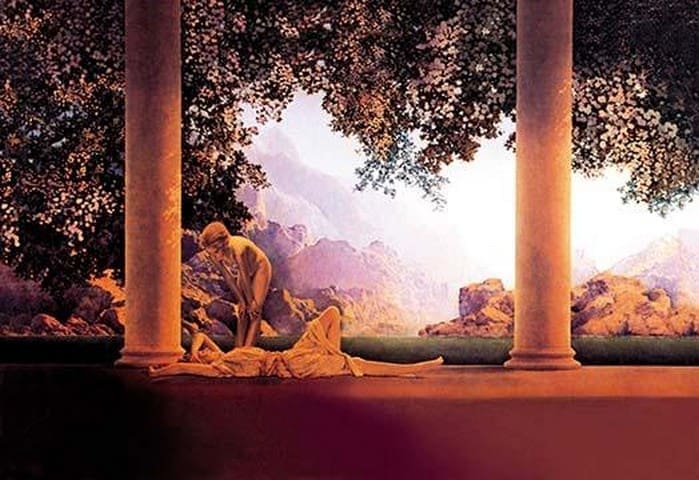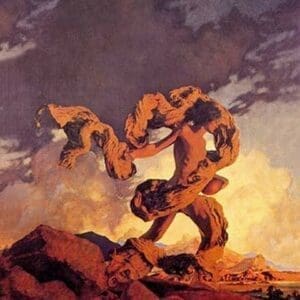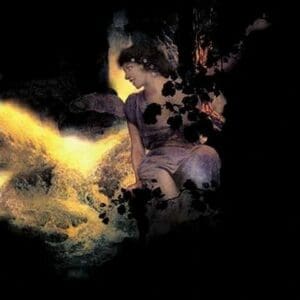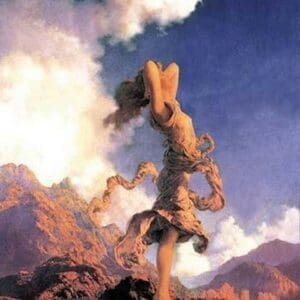Why Daybreak by Maxfield Parrish Became the Most Popular Print of the 20th Century

Few artworks have achieved the universal recognition of Maxfield Parrish’s 1922 masterpiece, “Daybreak.” At its peak, this luminous image hung in an estimated one out of every four American homes, making it the most reproduced print of the 20th century. What set it apart wasn’t just Parrish’s meticulous technique but also a groundbreaking approach to marketing that made fine art accessible to the masses.
The Artistic Brilliance Behind the Image
Parrish was already a celebrated illustrator before creating what would become his most famous work, known for pieces like “The Lantern Bearers” and “Garden of Allah.” His art blended fantasy with classical influences, often featuring idyllic landscapes, ethereal lighting, and striking architectural elements.
The radiant scene at the heart of his 1922 painting showcases two figures—one reclining, the other stretching as dawn breaks—framed by Greco-Roman columns. The dreamlike quality comes from Parrish’s masterful glazing technique, where he applied multiple transparent layers of oil paint over a white base. This process allowed light to reflect through the colors, producing an almost glowing effect.
A key feature of his palette was the deep cobalt known as “Parrish Blue,” which he used extensively in the sky and shadows. His compositions were also carefully planned using photographic references, ensuring an idealized yet highly detailed aesthetic. The overall effect was both otherworldly and comforting, offering a vision of serenity that resonated deeply with audiences.
How It Became a Cultural Phenomenon
While Parrish’s earlier works had been successful, nothing approached the reach of his most famous print. Its extraordinary popularity was due not only to its beauty but also to an unprecedented marketing strategy that brought fine art into everyday homes.
1. Mass Production and Retail Expansion
The image was published by House of Art, a leading print distributor, which recognized its commercial potential. Unlike traditional art prints, which were often limited in production, this one was mass-produced in various sizes and made available in department stores, furniture retailers, and mail-order catalogs. By removing the exclusivity of fine art, publishers ensured that middle-class households could easily purchase a copy.
2. Commercial Partnerships and Advertising
Beyond print sales, the image’s influence spread through advertisements, calendars, and greeting cards, further embedding it into American culture. Companies like General Electric used Parrish’s artwork in their marketing, associating their products with the dreamy, aspirational aesthetic his paintings provided.
3. Ubiquity in Popular Culture
Over the decades, the scene continued to inspire filmmakers, set designers, and even musicians. Michael Jackson famously referenced it in his “You Are Not Alone” music video, keeping the image alive for new generations. Its influence extended into Hollywood, shaping the look of fantasy and romance films that sought to capture the same luminous, enchanted atmosphere.
The Lasting Legacy
Maxfield Parrish created many unforgettable works, from the celestial glow of “Enchantment” to the golden radiance of “Ecstasy,” but none reached the legendary status of his 1922 masterpiece. The combination of technical brilliance, emotional resonance, and strategic marketing made it more than just a painting—it became a fixture of American life.
Today, its legacy endures, influencing contemporary artists and collectors alike. The same principles that made it a best-seller—universal appeal, mass accessibility, and strong branding—are still at play in the art world, proving that beauty, when paired with smart distribution, can transcend time.



